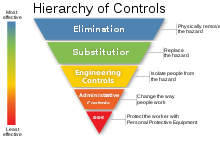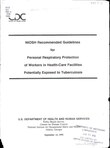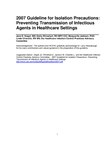

Source control is a strategy for reducing disease transmission by blocking respiratory secretions produced through breathing,[1] speaking, coughing, sneezing[2] or singing.[3] Multiple source control techniques can be used in hospitals,[4] but for the general public wearing personal protective equipment during epidemics or pandemics, respirators provide the greatest source control,[1] followed by surgical masks, with cloth face masks recommended for use by the public only when there are shortages of both respirators and surgical masks.[5][6][7]
Mechanisms

Infections in general may spread by direct contact (for example, shaking hands or kissing), by inhaling infectious droplets in the air (droplet transmission), by inhaling long-lasting aerosols with tiny particles (airborne transmission), and by touching objects with infectious material on their surfaces (fomites). Different diseases spread in different ways; some spread by only some of these routes. For instance, fomite transmission of COVID-19 is thought to be rare while aerosol, droplet and contact transmission appear to be the primary transmission modes, as of April 2021.[9]
Coughs and sneezes can spread airborne droplets up to ~8 meters (26 ft). Speaking can spread droplets up to ~2 meters (6.6 ft).[8]
Masking any person who may be a source of infectious droplets (or aerosols) thus reduces the unsafe range of physical distances. If a person can be infectious before they are symptomatic and diagnosed, then people who do not yet know if they are infectious may also be a source of infection.
For pathogens transmitted through the air, strategies to block cough air jets and to capture aerosols, e.g. the "Shield & Sink" approach, can be highly effective in minimizing exposure to respiratory secretions.[7]
Outside of respiratory source control, handwashing helps to protect people against contact transmission, and against indirect droplet transmission. Handwashing removes infectious droplets that their mask caught (from either side) and which transferred to their hands when they touched their mask.[8]
Contrast with personal protective equipment

While source control protects others from transmission arising from the wearer, personal protective equipment protects the wearer themselves.[10] Cloth face masks can be used for source control (as a last resort) but are not considered personal protective equipment[2][10] as they have low filter efficiency (generally varying between 2–60%), although they are easy to obtain and reusable after washing.[11] There are no standards or regulation for self-made cloth face masks,[12] and source control on a well-fitted cloth mask is worse than a surgical mask.[6]
Surgical masks are designed to protect against splashes and sprays,[5] but do not provide complete respiratory protection from germs and other contaminants because of the loose fit between the surface of the face mask and the face.[13] Surgical masks are regulated by various national standards to have high bacterial filtration efficiency (BFE).[14][15][16] However, source control is less than that of a respirator without an exhalation valve.[1] N95/N99/N100 masks and other filtering facepiece respirators can provide source control in addition to respiratory protection, but respirators with an unfiltered exhalation valve may not provide source control and require additional measures to filter exhalation air when source control is required.[5][1]
| Type | Source control | Inhaled air filtration | Ref |
|---|---|---|---|
| Cloth face mask | [2][10][6] | ||
| Surgical mask or procedure mask | [5][13][1] | ||
| Respirator without exhalation valve | [5] | ||
| Respirator with unfiltered exhalation valve | [5][1] | ||
| Respirator with filtered exhalation valve | [5] |
Source Control during TB Outbreaks
US HIV/AIDS Epidemic



HIV was a noted co-infection in around 35% of those affected by TB in some regions of the US,[19] despite extended close contact being a requisite factor for infection. Respirable particles are noted to be created by handling TB-infected tissue, or by coughing by those actively infected. Once in the air, droplet nuclei can persist in unventilated spaces. Most people infected with TB are asymptomatic, unless the immune system is weakened by some other factor, like HIV/AIDS, which can turn a infected person's latent TB into active TB source.[4]
1994 CDC guidelines brought three methods of source control for the prevention of TB: administrative controls, engineering controls, and personal protective equipment, particularly with the use of fit-checked respirators.[20]
Administrative controls mainly involve people and areas in hospital responsible for TB controls, including training, skin-testing, and regulatory compliance, as well as those responsible for quantifying the amount of TB present in the hospital's community and in-hospital, like staff. To assist with this, OSHA proposed TB guidelines in 1997,[20] but withdrew them in 2003 following the decline of TB.[21]
Engineering controls mainly involve ventilation and planning isolation rooms,[20] but can also involve environmental controls, like negative pressure, ultraviolet germicidal radiation, and the use of HEPA filters.[22]
The use of personal protective equipment, in this system of TB controls, requires the use of respirators whenever personnel are in contact with someone suspected of having TB, including during transport. This includes anyone near the infected person, all of whom must be provided with some sort of personal protective equipment, to avoid contracting TB. If PPE cannot be provided in time, the infected patient should be delayed from being moved through an area not controlled by PPE until the controls are in place, unless the care of the infected patient is compromised by an administrative delay.[20]
During TB outbreaks in the 1990s, multiple hospitals upgraded their controls and policies to attenuate the spread of TB.[18]
COVID-19 pandemic

Pre-COVID
In 2007, the CDC HICPAC published a set of guidelines, called the 2007 Guideline for Isolation Precautions: Preventing Transmission of Infectious Agents in Healthcare Settings, suggesting that use of "barrier precautions", defined as "masks, gowns, [and] gloves", would not be required, so long as it was limited to "routine entry", patients were not confirmed to be infected, and no aerosol-generating procedures were being done. "Standard precautions" requiring the use of masks, face shields, and/or eye protection, would be needed if there was potential for the spraying of bodily fluids, like during intubation.[23]
The guidelines are the same regardless of the type of pathogen, but the guidelines also note that, based on the experience of SARS-CoV in Toronto, that "N95 or higher respirators may offer additional protection to those exposed to aerosol-generating procedures and high risk activities".[23]
However, separate from "barrier precautions" and "standard precautions" are "airborne precautions", a specific protocol for "infectious agents transmitted by the airborne route", like with SARS-CoV and tuberculosis, requiring 12 air changes per hour for new facilities, and use of fitted N95 respirators. These measures should be used whenever someone is suspected of harboring an "infectious agent".[23]
Early Measures
During the COVID-19 pandemic, cloth face masks for source control had been recommended by the U.S. Centers for Disease Control and Prevention (CDC) for members of the public who left their homes, and health care facilities were recommended to consider requiring face masks for all people who enter a facility. Health care personnel and patients with COVID-19 symptoms were recommended to use surgical masks if available, as they are more protective.[24] Masking patients reduces the personal protective equipment recommended by CDC for health care personnel under crisis shortage conditions.[25]
Post-2023
However, by 2023, The New York Times noted that the CDC had dropped mandates for masks during COVID, limiting the COVID policies to an advisory role. Use of masks for source control is still recommended in times of high viral activity, but the CDC did not provide numbers for benchmarks. The new policies are thought to increase mortality among vulnerable patients, especially those with cancer.[26]
The New York Times article cites a paper published in 2023, that suggests the high mortality of cancer patients following the Omicron wave may have been due to relaxing of policies preventing COVID-19 transmission[27] (like source control policies). The 2023 paper also cites a research letter published in 2022, that suggests that the surge of COVID-19 cases in hospitals may have been due to the high contagiousness of Omicron,[28] an article which suggested a high secondary attack rate relative to Delta,[29] and papers finding increased mortality of cancer patients due to higher rates of breakthrough infections.[30][31]
Also in 2023, new draft guidelines were proposed by the CDC HICPAC, to update the pre-COVID 2007 Guideline for Isolation Precautions: Preventing Transmission of Infectious Agents in Healthcare Settings.[a] The proposed updates were met with disapproval; some felt that the changes did not go far enough.[26] Clarifications included adding "source control" as a qualification for the use of "barrier precautions".[32]
Notes
References
- ^ a b c d e f g Hazard JM, Cappa CD (June 2022). "Performance of Valved Respirators to Reduce Emission of Respiratory Particles Generated by Speaking". Environmental Science & Technology Letters. 9 (6): 557–560. Bibcode:2022EnSTL...9..557H. doi:10.1021/acs.estlett.2c00210. PMID 37552726.
- ^ a b c "FAQs on the Emergency Use Authorization for Face Masks (Non-Surgical)". U.S. Food and Drug Administration. 2020-04-26. Retrieved 2020-05-21.
- ^ Naunheim MR, Bock J, Doucette PA, Hoch M, Howell I, Johns MM, et al. (September 2021). "Safer Singing During the SARS-CoV-2 Pandemic: What We Know and What We Don't". Journal of Voice. 35 (5): 765–771. doi:10.1016/j.jvoice.2020.06.028. PMC 7330568. PMID 32753296.
- ^ a b "Basics of Tuberculosis.". Tuberculosis in the Workplace. National Academies Press (US). 2001.
- ^ a b c d e f g "Interim Infection Prevention and Control Recommendations for Patients with Suspected or Confirmed Coronavirus Disease 2019 (COVID-19) in Healthcare Settings". U.S. Centers for Disease Control and Prevention. 2020-05-18. Retrieved 2020-05-21.
- ^ a b c Koh XQ, Sng A, Chee JY, Sadovoy A, Luo P, Daniel D (February 2022). "Outward and inward protection efficiencies of different mask designs for different respiratory activities". Journal of Aerosol Science. 160. Bibcode:2022JAerS.16005905K. doi:10.1016/j.jaerosci.2021.105905.
- ^ a b Hunziker P (2020-12-16). "Minimizing exposure to respiratory droplets, 'jet riders' and aerosols in air-conditioned hospital rooms by a 'Shield-and-Sink' strategy". medRxiv 10.1101/2020.12.08.20233056v1.
- ^ a b c Sommerstein R, Fux CA, Vuichard-Gysin D, Abbas M, Marschall J, Balmelli C, et al. (July 2020). "Risk of SARS-CoV-2 transmission by aerosols, the rational use of masks, and protection of healthcare workers from COVID-19". Antimicrobial Resistance and Infection Control. 9 (1): 100. doi:10.1186/s13756-020-00763-0. PMC 7336106. PMID 32631450.
- ^ Carbone M, Lednicky J, Xiao SY, Venditti M, Bucci E (April 2021). "Coronavirus 2019 Infectious Disease Epidemic: Where We Are, What Can Be Done and Hope For". Journal of Thoracic Oncology. 16 (4): 546–571. doi:10.1016/j.jtho.2020.12.014. PMC 7832772. PMID 33422679.
- ^ a b c "Meat and Poultry Processing Workers and Employers: Interim Guidance from CDC and the Occupational Safety and Health Administration (OSHA)". Centers for Disease Control and Prevention. 2020-05-12. At section "Cloth face coverings in meat and poultry processing facilities". Retrieved 2020-05-24.
- ^ Rengasamy S, Eimer B, Shaffer RE (October 2010). "Simple respiratory protection--evaluation of the filtration performance of cloth masks and common fabric materials against 20-1000 nm size particles". The Annals of Occupational Hygiene. 54 (7). Oxford University Press: 789–798. doi:10.1093/annhyg/meq044. PMC 7314261. PMID 20584862.
The results showed that cloth masks and other fabric materials tested in the study had 40–90% instantaneous penetration levels against polydisperse NaCl aerosols employed in the National Institute for Occupational Safety and Health particulate respirator test protocol at 5.5 cm s−1.
- ^ "Community Respirators and Masks". NIOSH. 21 June 2023. Retrieved 2024-06-22.
- ^ a b "N95 Respirators and Surgical Masks (Face Masks)". U.S. Food and Drug Administration. 2020-04-05. Retrieved 2020-05-23.
- ^ Robertson P (15 March 2020). "Comparison of Mask Standards, Ratings, and Filtration Effectiveness". Smart Air Filters.
- ^ 中华人民共和国医药行业标准:YY 0469–2011 医用外科口罩 (Surgical mask) (in Chinese)
- ^ 中华人民共和国医药行业标准:YY/T 0969–2013 一次性使用医用口罩 (Single-use medical face mask) Archived 2021-02-25 at the Wayback Machine (in Chinese)
- ^ "DEPARTMENT OF LABOR Occupational Safety and Health Administration 29 CFR Part 1910 [Docket No. H-371] RIN 1218-AB46 Occupational Exposure to Tuberculosis".
- ^ a b "Implementation and Effects of CDC Guidelines". Tuberculosis in the Workplace. National Academies Press (US). 2001.
- ^ "Introduction". Tuberculosis in the Workplace. National Academies Press (US). 2001.
- ^ a b c d "Comparison of CDC Guidelines and Proposed OSHA Rule". Tuberculosis in the Workplace. National Academies Press (US). 2001.
- ^ "Part III DEPARTMENT OF LABOR Occupational Safety and Health Administration 29 CFR Part 1910 [Docket No. H-371] RIN 1218-AB46 Occupational Exposure to Tuberculosis".
- ^ Lee JY (October 2016). "Tuberculosis Infection Control in Health-Care Facilities: Environmental Control and Personal Protection". Tuberculosis and Respiratory Diseases. 79 (4): 234–240. doi:10.4046/trd.2016.79.4.234. PMC 5077726. PMID 27790274.
- ^ a b c "2007 Guideline for Isolation Precautions: Preventing Transmission of Infectious Agents in Healthcare Settings" (PDF).
- ^ "Interim Infection Prevention and Control Recommendations for Patients with Suspected or Confirmed Coronavirus Disease 2019 (COVID-19) in Healthcare Settings". U.S. Centers for Disease Control and Prevention. 2020-05-18. Retrieved 2020-05-21.
- ^ "Strategies for Optimizing the Supply of N95 Respirators". U.S. Centers for Disease Control and Prevention. 2020-04-02. At section "Prioritize the use of N95 respirators and facemasks by activity type". Retrieved 2020-05-21.
- ^ a b Mandavilli A (2023-09-23). "In Hospitals, Viruses Are Everywhere. Masks Are Not". New York Times. Retrieved 2024-06-27.
- ^ Potter AL, Vaddaraju V, Venkateswaran S, Mansur A, Bajaj SS, Kiang MV, et al. (October 2023). "Deaths Due to COVID-19 in Patients With Cancer During Different Waves of the Pandemic in the US". JAMA Oncology. 9 (10): 1417–1422. doi:10.1001/jamaoncol.2023.3066. PMID 37651113.
- ^ Klompas M, Pandolfi MC, Nisar AB, Baker MA, Rhee C (July 2022). "Association of Omicron vs Wild-type SARS-CoV-2 Variants With Hospital-Onset SARS-CoV-2 Infections in a US Regional Hospital System". Jama. 328 (3): 296–298. doi:10.1001/jama.2022.9609. PMC 9201738. PMID 35704347.
- ^ Lyngse FP, Mortensen LH, Denwood MJ, Christiansen LE, Møller CH, Skov RL, et al. (September 2022). "Household transmission of the SARS-CoV-2 Omicron variant in Denmark". Nature Communications. 13 (1): 5573. Bibcode:2022NatCo..13.5573L. doi:10.1038/s41467-022-33328-3. PMID 36151099.
- ^ Gong IY, Vijenthira A, Powis M, Calzavara A, Patrikar A, Sutradhar R, et al. (March 2023). "Association of COVID-19 Vaccination With Breakthrough Infections and Complications in Patients With Cancer". JAMA Oncology. 9 (3): 386–394. doi:10.1001/jamaoncol.2022.6815. PMC 10020872. PMID 36580318.
- ^ Potter AL, Vaddaraju V, Venkateswaran S, Mansur A, Bajaj SS, Kiang MV, et al. (October 2023). "Deaths Due to COVID-19 in Patients With Cancer During Different Waves of the Pandemic in the US". JAMA Oncology. 9 (10): 1417–1422. doi:10.1001/jamaoncol.2023.3066. PMID 37651113.
- ^ "Proposed Update to Guideline for Isolation Precautions: Preventing Transmission of Infectious Agents in Healthcare Settings (2007), 'Protective Environment' Recommendation" (PDF). Archived from the original (PDF) on 2023-08-22.


Recent Comments